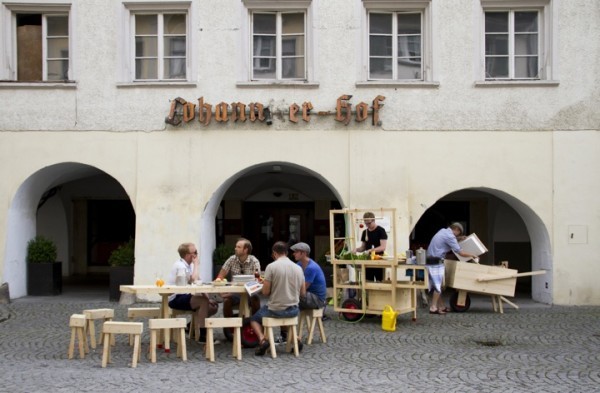My elementary school in California ran on a track based system. This means my school was split between four different tracks A - D. The track system was an alternative to the traditional school pacing, allowing for more frequent but only month long breaks. In retrospect I realize I would rather be on the traditional school schedule because my friend group was determined by who was a part of the same track as me. I didn't live near my friends and it was very difficult to see my friends during the breaks.

 Inspiring a sense of community across many European cities designers Ania Rosinke and Maciel Chmara started Mobile hospitality which provides a forum for people in urban and disconnected areas to come together and share a meal. Their designs are featured in the Museum of Applied Arts', known as MAK, Nomadic Furniture 3.0 exhibit. Their goal is to create innovative and functional furniture while maintaining public responsibility and initiative. Chmara and Rosinke's Mobile Hospitality project has furthered their goal of promoting public responsibility and initiative by encouraging social interaction and community. Sharing a meal and common space is an easy way for people to engage in conversation away from the hustle and bustle of the big city and in a more intimate setting. Weisberg's comments in Creativity: Beyond the Myth of Genius Chapter 4: Creative Problem Solving mentions "Expertise in Other Domains" and the application of expert knowledge in a certain field to a new or different area. Chmara and Rosinke's ability to create mobile and functional furniture was directly applicable to building a functional kitchen. However, the creative problem solving is seen in the purpose of the mobile kitchen. Where Chmara and Rosinke's earlier designs were intended for personal use, this new and creative design has stretched beyond the boundaries of the home and into the public sphere with a cause to connect people. Below is a video and a couple links displaying the culinary and artistic abilities of the dynamic duo.
Inspiring a sense of community across many European cities designers Ania Rosinke and Maciel Chmara started Mobile hospitality which provides a forum for people in urban and disconnected areas to come together and share a meal. Their designs are featured in the Museum of Applied Arts', known as MAK, Nomadic Furniture 3.0 exhibit. Their goal is to create innovative and functional furniture while maintaining public responsibility and initiative. Chmara and Rosinke's Mobile Hospitality project has furthered their goal of promoting public responsibility and initiative by encouraging social interaction and community. Sharing a meal and common space is an easy way for people to engage in conversation away from the hustle and bustle of the big city and in a more intimate setting. Weisberg's comments in Creativity: Beyond the Myth of Genius Chapter 4: Creative Problem Solving mentions "Expertise in Other Domains" and the application of expert knowledge in a certain field to a new or different area. Chmara and Rosinke's ability to create mobile and functional furniture was directly applicable to building a functional kitchen. However, the creative problem solving is seen in the purpose of the mobile kitchen. Where Chmara and Rosinke's earlier designs were intended for personal use, this new and creative design has stretched beyond the boundaries of the home and into the public sphere with a cause to connect people. Below is a video and a couple links displaying the culinary and artistic abilities of the dynamic duo.Mobile Hospitality
mobile hospitality by chmara.rosinke
The mobile furniture reminds me a lot about the management course I took with Amy Kyhos. We discussed the importance of change in smaller organizations because a consistent supply of new ideas help them grow. An article she showed us had a company change the employees' seating every week. Because every worker had to interact with new people every week, there was a huge increase in ingenuity. This occurred because everyone's thought processes changed as they conversed with new people.
ReplyDeleteI really liked the community point you made because I think that is just as big a factor as the "newness". Obviously ingenuity is a big part about creativity, but so is cooperation. When people are more comfortable with each other and support each other, they get the confidence to work on bigger and harder projects. I know the creative people in our 2 in class films all had strong communities.